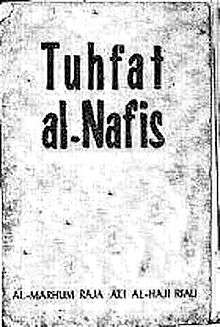Tuhfat al-Nafis

Tuhfat al-Nafis (The Precious Gift) is a work of Malay literature written by Raja Ali Haji in Jawi in 1885.[1] who is of Malay-Bugis descent. It records and chronicles events, especially those of the 19th century, that occurred in several Malay states. Some of the events recorded in the work include the founding of the state of Terengganu and the murder of Sultan Mahmud Shah II of Johor. Tuhfat al-Nafis means "the precious gift" in the Arabic language.[2]
There are four manuscripts of Tuhfat al-Nafis. A manuscript copied in 1890 and published in 1923 is in the Journal of the Malayan Branch of the Royal Asiatic Society, London [1].
Tuhfat al-Nafis begins with a summary taken from the Sulalatus Salatin (Malay Annals), and then tell a more detailed history of the Johor-Riau Sultanate. Tuhfat was a dynamic figure in the Bugis principality, who with military and diplomatic dexterity managed to gain an important position in the Riau states, Selangor, Sambas and Matan-Sukadana.
A recurrent theme in the first half of Tuhfat al-Nafis is conflict between the Minangkabau people of Riau as well as Bugis and Malay alliance forces. The conflict occurred both in the provinces of Riau and in Kedah, Selangor, Siak and Kalimantan. The second half covers the middle of the 18th century until 1864, showing the growing hostility between the Bugis and Malays in Riau, and two raids led by the Bugis people of Malacca to the Dutch in 1756 and 1784. The last attack ended when the Dutch signed a treaty with the Sultan of Riau who conceded his kingdom as a fief of the Dutch East India Company.